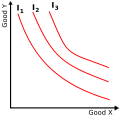
Ordinal utility
Encyclopedia
Ordinal utility theory states that while the utility
of a particular good or service cannot be measured using a numerical scale bearing economic meaning in and of itself, pairs of alternative bundles (combinations) of goods can be ordered such that one is considered by an individual to be worse than, equal to, or better than the other. This contrasts with cardinal utility
theory, which generally treats utility as something whose numerical value is meaningful in its own right.
 Each indifference curve
Each indifference curve
is a set of points, each representing a combination of quantities of two goods or services, all of which combinations the consumer is equally satisfied with. The further a curve is from the origin, the greater is the level of utility. The slope of the curve (the negative of the marginal rate of substitution
of X for Y) at any point shows the rate at which the individual is willing to trade off good X against good Y maintaining the same level of utility. The curve is convex to the origin as shown assuming the consumer has a diminishing marginal rate of substitution. It can be shown that consumer analysis with indifference curves (an ordinal approach) gives the same results as that based on cardinal utility
theory — i.e., consumers will consume at the point where the marginal rate of substitution between any two goods equals the ratio of the prices of those goods (the equi-marginal principle).

where x and y are the quantities of the goods consumed. Both partial derivatives of this function are positive if the consumer prefers more of both goods. But the same preferences could be expressed as another utility function that is a monotonic transformation of u:

where f is any globally increasing function. Utility functions g and u give rise to identical indifference curve mappings. Thus in ordinal utility theory, there is no concept of diminishing marginal utility, which would correspond to the second derivative of utility being negative. For example, even if u has a negative second derivative with respect to x, the equivalent utility function g may have a positive second derivative with respect to x.
Utility
In economics, utility is a measure of customer satisfaction, referring to the total satisfaction received by a consumer from consuming a good or service....
of a particular good or service cannot be measured using a numerical scale bearing economic meaning in and of itself, pairs of alternative bundles (combinations) of goods can be ordered such that one is considered by an individual to be worse than, equal to, or better than the other. This contrasts with cardinal utility
Cardinal utility
In economics, cardinal utility refers to a property of mathematical indices that preserve preference orderings uniquely up to positive linear transformations...
theory, which generally treats utility as something whose numerical value is meaningful in its own right.
Indifference curve mappings
When a large number of bundles of goods are compared, the preferences of the individual can be seen. This information is usually put together on a graph called an indifference map. One of these is shown below:
Indifference curve
In microeconomic theory, an indifference curve is a graph showing different bundles of goods between which a consumer is indifferent. That is, at each point on the curve, the consumer has no preference for one bundle over another. One can equivalently refer to each point on the indifference curve...
is a set of points, each representing a combination of quantities of two goods or services, all of which combinations the consumer is equally satisfied with. The further a curve is from the origin, the greater is the level of utility. The slope of the curve (the negative of the marginal rate of substitution
Marginal rate of substitution
In economics, the marginal rate of substitution is the rate at which a consumer is ready to give up one good in exchange for another good while maintaining the same level of utility.-Marginal rate of substitution as the slope of indifference curve:...
of X for Y) at any point shows the rate at which the individual is willing to trade off good X against good Y maintaining the same level of utility. The curve is convex to the origin as shown assuming the consumer has a diminishing marginal rate of substitution. It can be shown that consumer analysis with indifference curves (an ordinal approach) gives the same results as that based on cardinal utility
Cardinal utility
In economics, cardinal utility refers to a property of mathematical indices that preserve preference orderings uniquely up to positive linear transformations...
theory — i.e., consumers will consume at the point where the marginal rate of substitution between any two goods equals the ratio of the prices of those goods (the equi-marginal principle).
Revealed preference
Revealed preference theory addresses the problem of how to observe ordinal preference relations in the real world. The challenge of revealed preference theory lies in part in determining what goods bundles were foregone, on the basis of the being less liked, when individuals are observed choosing particular bundles of goods.Ordinal utility functions
An ordinal utility function describing a consumer's preferences over, say, two goods can be written as
where x and y are the quantities of the goods consumed. Both partial derivatives of this function are positive if the consumer prefers more of both goods. But the same preferences could be expressed as another utility function that is a monotonic transformation of u:

where f is any globally increasing function. Utility functions g and u give rise to identical indifference curve mappings. Thus in ordinal utility theory, there is no concept of diminishing marginal utility, which would correspond to the second derivative of utility being negative. For example, even if u has a negative second derivative with respect to x, the equivalent utility function g may have a positive second derivative with respect to x.
External Links
- Ordinal utility vs. Cardinal utility
- Murray N. Rothbard, "Towards a Reconstruction of Utility and Welfare Economics"

